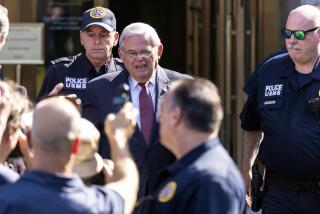Investigators Focus on Marcos’ Rich ‘Cronies’ : Millions From Secret Fund Reported Taken
- Share via
WASHINGTON — Former Philippine President Ferdinand E. Marcos and his wife, Imelda, allegedly misused millions of dollars of their government’s intelligence funds, according to documents released Thursday by a House subcommittee and according to federal court testimony by the head of a Philippine investigating commission.
The documents, released over Justice Department objections, appear to link Marcos to multimillion-dollar New York real estate holdings. They also detail “commissions” that Westinghouse Corp. paid for Philippine business to Swiss and Philippine accounts.
Protests Brushed Aside
Rep. Stephen J. Solarz (D-N.Y.), chairman of the House Foreign Affairs subcommittee on Asia and the Pacific, brushed aside Justice Department protests that release of the documents could thwart the following up of investigative leads, saying that the subcommittee has concluded that release of the papers would not hurt any continuing grand jury probes.
Testifying in a federal court hearing in New York, Jovito R. Salonga, head of a Philippine commission that is investigating alleged corruption during the 20-year Marcos rule, said that Marcos had funneled millions of dollars through a secret “intelligence” fund that was used to make large, unexplained payments during foreign trips by his family.
Salonga submitted documents at the hearing indicating that Imelda Marcos may have spent $3.5 million for a Michelangelo painting and $2.5 million for jewelry during 1983 trips to New York.
According to an associate of Imelda Marcos, who declined to be identified, the former Philippine First Lady had said that she paid “wholesale” prices for many of her purchases and that they were not for her personal use but were intended for visiting dignitaries and other official recipients of gifts.
Salonga’s testimony and the documents released by the House subcommittee showed that the Marcoses made heavy use of government intelligence funds for their foreign travel.
A document labeled “Philippine Intelligence Fund--resume of disbursements made, 1981,” and printed on the stationery of the Philippine National Bank, listed Imelda Marcos as spending $200,000 on an “official trip” to Nairobi, Kenya, in August, 1981, and the same amounts for visits to Iraq in September, 1981, and New York three months later.
Marcos himself was listed as having incurred expenses of $652,000 in three separate disbursements from the intelligence fund in connection with a trip to Cancun, Mexico, in October, 1981, to attend an international economic summit meeting.
Most of the documents made public Thursday were seized by the U.S. Customs Service when the Marcoses fled to Hawaii last month. But Solarz also made public a “declaration of trust” that he said shows Marcos is the “presumptive owner” of a valuable piece of New York real estate, the Crown Building.
The declaration of trust, which Solarz said was found in the presidential palace after Marcos fled from Manila, was dated April 4, 1982, and was signed by Joseph E. Bernstein, one of two brothers investigated by the subcommittee for allegedly arranging real estate purchases for the Marcoses in New York.
In the declaration, Bernstein said he would act as a trustee for Marcos’ benefit in all matters relating to Lastura Corp., which Solarz described as the holding company for the Crown Building.
Another document made public by the subcommittee showed that Westinghouse had paid $11,210,434 in commissions from 1976 to 1982 to the Herdis Management & Investment Corp. in connection with a nuclear power plant that Westinghouse built on the Bataan Peninsula. Herdis was owned by Herminio Disini, a golfing friend of Marcos.
Westinghouse has stated that a Justice Department investigation in 1977 found no evidence that any of its commissions were passed on to any Philippine government official. But Justice Department sources have said that the Westinghouse commissions are under scrutiny by a federal grand jury in Pittsburgh.
Other documents that were made public suggested that Marcos made a practice of accepting stock or cash from wealthy Filipino businessmen.
In a letter from Europe on March 11, 1982, Disini remitted stock to Marcos in one of Disini’s companies without any specific explanation for his action.
“Dear Sir,” Disini wrote. “Here are stock certificates for 2.5 billion shares of Vulcan Industrial and Mining Corp. and 4 billion shares of The Energy Corp. These shares represent 17% ownership in VIMC and 26.7% in TEC.”
A related document in Marcos’ files indicated that Disini’s company, Herdis, had overseas assets valued at $25.7 million, including substantial deposits at the United Orient Bank in New York.
A memorandum to Marcos from an unidentified presidential aide in 1979 also suggested that Marcos had plans to receive cash sums from a major Filipino importer.
This memo “for the President” said that Alberto T. Looyuko, proprietor of Noah’s Ark Merchandising, had “renewed his request for help to import sardines and mackerels.” The aide told Marcos in the document that Looyuko would provide a “donation” based on the volume of his imports and “promised to import regularly if the President helps him.”
Times staff writers Bob Secter and Michael Wines contributed to this story.
More to Read
Sign up for Essential California
The most important California stories and recommendations in your inbox every morning.
You may occasionally receive promotional content from the Los Angeles Times.













